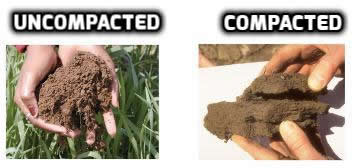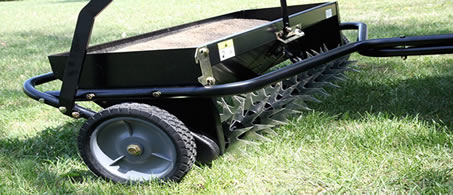Best Time To Aerate And Overseed Lawn For Best Results

Aeration is an often overlooked part of lawn care, especially with residential users who care for their own lawns. Even people who understand that they need to aerate don’t really fully understand what it is and why it is so important to the health of their lawn.
The best times to aerate and overseed are season-dependent. If you aerate turf when it’s too wet or too dry you risk damaging the lawn.
There are also specific times you should aerate depending on the type of grass you have on your lawn. Let’s take a closer look at the best time and the best way to aerate and overseed your lawn.
Table of Contents
The benefits of lawn aeration
Every lawn will need aerated sooner or later.
What is aeration anyway?
Aeration is necessary because the turf in a lawn becomes either compacted with hard soil or gets filled with thatch.
By a process of aeration small holes are punched in the soil so that much needed water, oxygen and nutrients can penetrate deep into the lawn to feed the roots of grass and other plants in your garden.
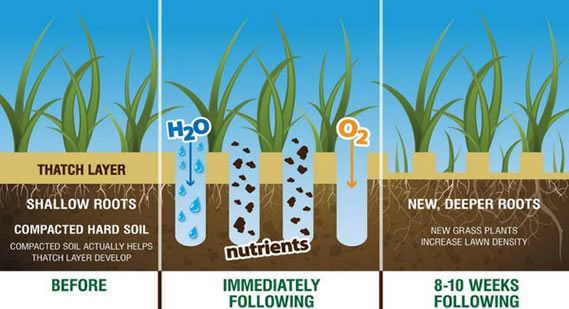
Why you should aerate every 2 years
Although aeration helps to control pests and pathogens, while simultaneously encouraging compost development, there are two main reasons why you should aerate your lawn.
They are:
- To combat compaction.
- To penetrate thatch build-up.
Let’s look at these reasons for aeration a little bit closer.
Soil compaction starves grass roots of oxygen, water and nutrients
When it comes to residential lawns the biggest reason for needing to aerate is to alleviate the problems associated with soil compaction.
When people and animals walk on a lawn they force the top soil down and compact the soil layers below it. Over time this compacted soil forms a layer of solid turf that stops nutrients, water and air from getting to the roots of grass below it.
When a lawn is heavily used it tends to compact sooner than a lawn that is used only infrequently but if you, or your pets, use your lawn at all then it will need aerated at least once per year.
A dry climate can also lead to soil compaction due to the turf drying out.
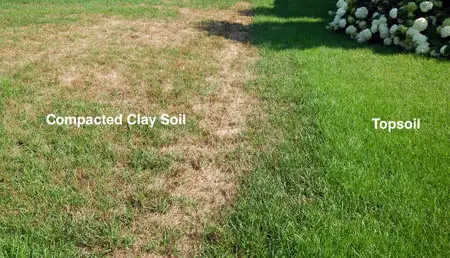
Thatch build-up has a similar effect
Although it is not as common, especially on residential lawns, thatch build-up is another reason for aerating your lawn.
What is thatch?
Thatch is a layer of loose and intermingled organic matter. This organic matter consists of dead and living roots, shoots and stems.
This thatch layer, when it is allowed to build-up too much, forms an impenetrable barrier between the roots of grass and the top soil.
This barrier then stops anything getting through thus robbing those roots of much needed water, air and nutrients. They simply cannot penetrate the hard barrier.

A certain amount of thatch in the turf is normal and even healthy (micro-organisms feed on this thatch and keep the soil nutrient-rich).
However, when this thatch builds up faster than the micro-organisms can break it down your lawn suffers from thatch build-up.
The best time to aerate your lawn
Obviously you will ant to know the best time to aerate turf before you embark on a quest to punch holes in your lawn.
There are specific times that you should aerate your lawn.
However, more importantly there are specific times when you should not attempt to aerate your lawn or you will run the risk of damaging it.
But, before we touch on the best times of the year to aerate we will look at the signs to look for that shows your lawn is letting you know that it’s time to aerate.
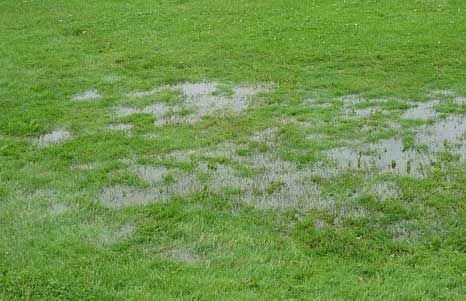
You should aerate when you identify soil compaction
If you are unsure whether the turf in your lawn is compacted or not there is a simple test you can perform.
Take a screwdriver or similar implement and try to push it into the soil in your lawn.
If you can’t push it all the way through the soil to the hilt then the turf in your lawn is probably compacted.
If you can push the screw driver into the turf but it takes a lot of effort then the lawn still probably needs aerated.
You can also dig up a piece of the lawn to a depth of a few inches and you will see if the soil is very compacted simply by examining it.
You should dethatch first and then aerate when you see thatch build-up
Identifying thatch is pretty easy.
If the ground feels spongy when you walk on it then you most definitely have a build-up of thatch that needs attended to immediately.
You should be aware that when you have thatch build-up it is a very good idea to de-thatch (scarify) the lawn before you aerate it. De-thatching tools are relatively cheap and easy to use.
De-thatching the lawn is important to ensure there is a clear path for much-needed elements to reach the grass roots in the lawn. It will also ensure your aeration efforts are successful.
If you have chronic thatch build-up in an area then aeration alone may not solve the problem and your lawn will remain patchy and probably muddy in the wetter months.
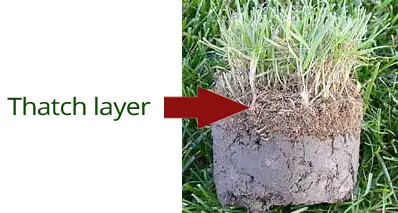
You can learn more about de-thatching in our post How to Aerate a Lawn by Hand.
You must avoid aerating at the wrong time
If you try to aerate your lawn out of season you run the risk of causing more harm than good.
You will also clog up the tines in the aerator and start making a mess of the lawn area.
Aerating a lawn when the soil is very wet is just not a good idea.
Do not aerate a lawn in the winter
When you aerate your lawn during the wetter months and when it is very wet you will probably just water-log the turf.
Likewise, if you aerate in the very cold months this will damage the lawn when water gets in the holes and turns to ice.
The ice will wedge the holes wider and ruin your entire lawn.
It can also lead to snow mold.
Ideally you should really try to avoid aeration during the cold months altogether.
Do not aerate during very dry spells
In the same way that very wet weather is a bad time to aerate, very dry weather is a bad time to aerate as well.
 When soil has dried out and you attempt to aerate it you run the very real risk of creating holes that open up and crack the turf on the entire lawn.
When soil has dried out and you attempt to aerate it you run the very real risk of creating holes that open up and crack the turf on the entire lawn.
Then when it eventually does rain the lawn may also become waterlogged.
The best time to aerate depends on the season and the grass
There may be, arguably, some better ways to aerate a lawn than others but there are definitely better seasons to aerate.
You should aim to de-thatch your lawn and aerate it during the growing season.
Aerating lawns with cool season grass
If your lawn has been seeded with cool season grass, such as Bentgrass, Kentucky bluegrass, all fescue varities, Creeping fescue, Annual ryegrass, Perennial ryegrass and Rough bluegrass, then you should aerate it in the early spring or early fall when the weather is not too warm and not cold.
You should also ensure your lawn has the right amount of moisture not being too dry or too wet.
Aerating lawns with warm season grass
If you have planted your lawn with warm season grass, such as Bahiagrass, Bermudagrass, Buffalograss, Centipedegrass, St. Augustinegrass and Zoysiagrass, then you should aim to aerate your lawn in the late spring.
Ensuring your lawn has the right amount of moisture before aeration can save you a lot of trouble
It is vital to ensure your lawn has the right amount of moisture before you start aerating it.
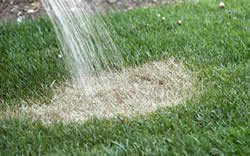 As I have already mentioned, a lawn that is too wet is not a good candidate for aeration. Likewise a lawn that has soil that is too dry is also not a good candidate for aeration either.
As I have already mentioned, a lawn that is too wet is not a good candidate for aeration. Likewise a lawn that has soil that is too dry is also not a good candidate for aeration either.
If the soil is too wet then you will need to wait until the turf drys out.
If the soil is too dry you will have to water the lawn and wait a day or two to ensure the water penetrates the soil.
This is one of the reasons for aerating in the dryer months as it is easier to add moisture to a lawn than it is to dry it out!
Once you’ve aerated it’s time for overseeding
Overseeding involves planting grass seed directly onto turf without having to turn the soil. You simply sprinkle grass seed on the lawn turf directly.
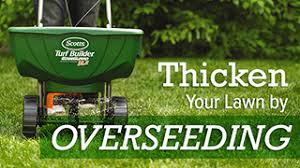 It’s a very popular way of filling in bare spots, improving the density of the turf and enhancing your lawn’s overall color – especially after aeration.
It’s a very popular way of filling in bare spots, improving the density of the turf and enhancing your lawn’s overall color – especially after aeration.
Why it’s a good idea to overseed your lawn
Often we notice that a lawn that is in need of aeration, and perhaps de-thatching, has bare patches in the summer and/or muddy patches in the winter.
So, after aeration it is a good idea to overseed the effected areas to fill in those damaged lawn areas.
The best time to overseed your lawn is directly after you have aerated it
The reason these combo tools are so effective is because the best time to overseed is directly after you aerate.
Just as there are super easy to use aeration tools, there are also seeders to make the job of spreading that grass seed easier too.
You can do both at the same time – aerator/seeder combos
Are you aware that there are aerator seeder combos as well?
This combo machines give you both and aerator and overseeder in one handy and very effective garden tool.
Summary: Guide to Aerating and Overseeding Your Lawn
Just as there are good times to aerate and overseed, there are also bad times to do it.
Ensure you avoid attempting aeration out of season or you run the real risk of destroying your whole lawn.
Before you aerate consider dethatching. Before aeration check to see if your lawn has a thatch build-up problem.
If it does then you should de-thatch it first.
When you do aerate, make sure that the lawn has the correct amount of moisture so you avoid leaving holes that will later lead to water-logging and/or other damage.
Once you have aerated the lawn you should overseed it immediately for best results.
It is often best to use a broadcast seeder or handheld seeder. Alternatively, you can use a combo tool that aerates and overseeds at the same time, as described above.
Thanks for reading! I'm Michael — houseplant fanatic and your Pinterest plant guide.
Follow me on Pinterest for fresh updates 🌿

